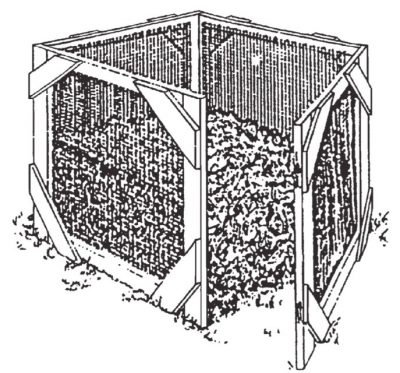COMPOST BIN (4’X 4’X 4’)
LUMBER NEEDED

DIRECTIONS
- Place two E pieces on the ground with the outside edges four feet apart with the 1 1/2” side up.
- Place six A pieces horizontally an equal distance apart (about one inch) from top to bottom and nail to the E pieces. Repeat this process and you have constructed the two sides.
- Stand the two sides four feet apart and nail six more A pieces horizontally to catch the sides, and you have constructed the back.
- Nail one D piece vertically 3/4” away from piece E to make a 3/4” slot between the D piece and the E piece at the open end of the bin. (This slot is a track into which the five B pieces will be inserted.) Do the same with the other D piece on the other side of the open end.
- Nail the C piece across the open end, inside the slot (horizontally at the bottom) to match the level of the A pieces at the bottom of the sides.
- The remaining five B boards should fit into the groove. Put two nails into the bottom (1” edge) of each board, leaving about one inch of the nail protruding to separate the boards at the same interval as on the sides and the back.
- Nail the G pieces at the end of the F pieces, forming a lip at each end to make a spreader bar. This should be put across the top of the bin to prevent spreading as the bin fills with compost.
WIRE BIN (3’X 3’X 3’)
LUMBER NEEDED
16 pieces 1” x 4” x 3’
1 piece 1” x 4”x 16’ for corner braces
MATERIALS NEEDED
12 feet of 36”wide 1/2”hardware cloth
32 joint fasteners
150 poultry wire staples or power stapler
Four 3” galvanized butt door hinges
Four large hook‐and‐eye gate latches

DIRECTIONS
- Make a 3‐foot square of 1” x 4”with two 3’ lengths and two shorter pieces to fit between them.
- Join these boards with two joint fasteners at each corner to hold them together.
- On the other side, nail or screw a corner brace to each corner.
- On the side with joint fasteners, put a 3’ x 3’ piece of hardware cloth. Bend over edges 1” and staple wire every 4” to the wood, keeping it as tight as possible.
- Construct three other sides the same way.
- Connect each pair of frames with two hinges.
- Then put the hook and eye gate latches on the other ends so that the sections latch together.
MORE COMPOSTING EQUIPMENT
Many materials and tools are sold to help the home composter. Some are listed here:
- Chipper/Shredders – Break the plant material into smaller pieces. They may chip branches of various sizes as well.
- Aerators – Enable air to penetrate into the pile.
- Thermometers –Monitor existing compost pile temperatures.
- Compost Bins – Confine the composting material in a defined space. They may be made of wood, wire or brick.
- These materials can be found at garden centers and other retailers that sell gardening products. In addition, garden supply catalogs offer some or all of
these products.
READING MATERIALS
Numerous sources of information dealing with composting are available from magazines, books, gardening programs and internet sites. Many gardening books in your local library have information on composting. The following books contain valuable information on composting and are available from many local bookstores or garden centers. Although not a complete list, they are representative of current knowledge about composting at the home level.
Composting Basics: All the Skills & Tools You Need to Get Started by Eric Ebeling with Carl Hursh & Patti Olenick. Stackpole Books. 2017/ ISBN 9780811718370
Composting: The Ultimate Guide to Creating Your Own Organic Compost… by Dion Rosser. Primasta. 2021. ISBN 978-1638181378
Let It Rot by Stu Campbell. Storey Communication.1998. ISBN 1580170234
Organic Book of Compost (2nd revised ed) by Pauline Pears. IMM Lifestyle Books.2020. ISBN 1504801237
Secrets to Great Soil by Elizabeth P. Stell. Storey Communications. 1998. ISBN 1580170080
The Complete Compost Gardening Guide by Barbara Pleasant & Deborah L. Martin. Storey Publishing. 2008. ISBN 1580177026
The Rodale Book of Composting – newly revised & updated. By Grace Gershuny & Deborah L.Martin (editors). Rodale Press. 2018. ISBN 1635651026
The Science of Composting: Life, Death & Decay in the Garden by Julian Doberski. Pimpernal Press. 2022 ISBN 1914902939
By Dawn Pettinelli, Associate Extension Educator, PSLA
Plans adapted by Master Composter Bob Eber
Questions? Contact:
UConn Soil Nutrient Analysis Laboratory
Department of Plant Science and Landscape Architecture
Phone: 860.486.4274
Email: soiltest@uconn.edu
Website: soiltesting.cahnr.uconn.edu
UConn is an equal opportunity program provider and employer.
©UConn Extension. All rights reserved.